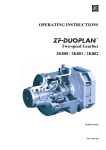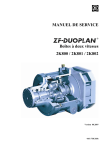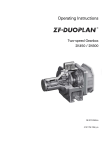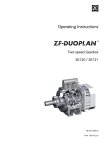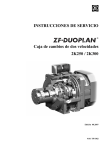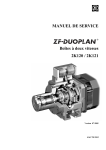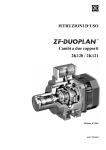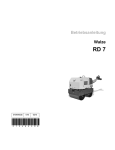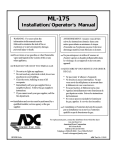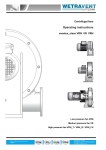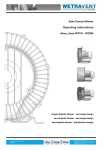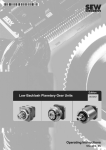Download 2K800 & 2K801 & 2K802 Manual - Drive Lines Technologies Ltd
Transcript
Operating Instructions Two-speed Gearbox 2K800 / 2K801 / 2K802 08.2013 Edition 4161 758 103m_en 2K800/2K801/2K802 NOTE These operating instructions also apply to the predecessor model 2K50. Subject to alterations in design Copyright by ZF Reproduction, in whole or in part, is only allowed with our written approval and authorization. Printed in Germany Edition: 2013-08 4161 758 103m 2 Operating Instructions 2K800/2K801/2K802 1 2 3 Contents Preface ...................................................................................................................................................5 1.1 Safety instructions .....................................................................................................................5 1.2 ZF instructions ...........................................................................................................................5 1.3 Service products ........................................................................................................................6 Application and Design ...........................................................................................................................7 2.1 Application ................................................................................................................................7 2.2 Features ....................................................................................................................................7 2.3 Design .......................................................................................................................................8 2.4 Technical data ...........................................................................................................................9 2.5 Installation positions ................................................................................................................10 Initial Installation ................................................................................................................................... 11 3.1 Axial runout, radial runout and length tolerances – drive motor .................................................11 3.2 Balancing ................................................................................................................................12 3.2.1 Semi-key balancing..................................................................................................................12 3.2.2 Full-key balancing ....................................................................................................................12 3.3 3.3.1 3.3.2 3.3.3 3.3.4 3.3.5 Adaptation, motor/gearbox ......................................................................................................13 Open design ............................................................................................................................13 Close design (with shaft sealing ring) .......................................................................................14 Open design with adapter ring for 2K800 and 2K801 ...............................................................15 Open design with adapter ring for 2K802 .................................................................................15 Version with pulley drive ..........................................................................................................16 3.4 Gearbox – fit ............................................................................................................................16 3.5 3.5.1 3.5.2 3.5.3 Output .....................................................................................................................................17 Version with belt output ...........................................................................................................17 Version with coaxial output ......................................................................................................17 Version without output .............................................................................................................17 3.6 Electrical connection, gearchange ............................................................................................18 3.6.1 Shift unit ..................................................................................................................................18 3.6.2 Shift logic ................................................................................................................................20 3.7 3.7.1 3.7.2 3.7.3 3.7.4 3.7.5 3.7.6 Lubrication ..............................................................................................................................21 Recirculating lubrication...........................................................................................................21 Recirculating lubrication for V1/B5 operation ............................................................................21 Recirculating lubrication with heat exchanger...........................................................................21 Recirculating lubrication with intermediate tank.......................................................................22 Ports and connections for recirculating lubrication ....................................................................23 Connections for recirculating lubrication for direct mounting on the headstock..........................24 3 Operating Instructions Contents 4 Taking into Operation............................................................................................................................25 4.1 5 7 4 Initial inspection ...................................................................................................................... 25 Maintenance.........................................................................................................................................25 5.1 6 2K800/2K801/2K802 Oil change ............................................................................................................................... 25 Repair...................................................................................................................................................26 6.1 Gearbox fault checklist............................................................................................................. 26 6.2 Gearbox – disassemble ............................................................................................................ 27 6.3 Hub ......................................................................................................................................... 27 Frequently Asked Questions (FAQ) ........................................................................................................28 Operating Instructions 2K800/2K801/2K802 1 Preface Preface 1.1 Safety instructions • All persons repairing ZF units are responsible for their own work safety. • The following safety notices are used in these operating instructions: Every applicable safety regulation and legal requirement must be complied with in order to prevent injury to personnel and/or damage to the product during the course of maintenance and repair work. • Repair staff should familiarize themselves with these regulations before commencing work. NOTE Used to highlight special sequences, methods, information, etc. • Correct and proper repair of these ZF products can only be assured by appropriately trained specialists. • The organization in charge of repairs is responsible for ensuring that such training is given. • Read these operating instructions carefully before commencing any testing or repair work. This documentation is intended for specialists who have experience to carry out maintenance and repair work. The ZF product is documented in accordance with the design status as of the issue date. CAUTION Used when incorrect and improper operating procedures can cause damage to the product. ! ! DANGER! Used when due lack of care and attention can cause injury to personnel and/or damage to property. ENVIRONMENTAL HAZARDS! Lubricants and cleaning products must not be poured onto the ground, into groundwater or down the drain. • Obtain and comply with the safety regulations relevant to these products issued by your local environmental authority. • Collect used oil in a suitably large container. • Dispose of used oil, clogged filters, lubricants and cleaning products in accordance with local environmental protection regulations. • Always follow the instructions issued by the manufacturer when handling lubricants and cleaning products. CAUTION Pictures, drawings and components do not always represent the original object but are used to illustrate working procedures. The illustrations, diagrams and parts are not drawn to scale and no assumptions should be made regarding size and weight (including within a single illustration or drawing). Work must be performed as described in the text. Following the completion of repair work and testing, the specialists must satisfy themselves that the product will function perfectly again. 1.2 ZF instructions • Remove any traces of old seals or gaskets from mating faces. Use an oil stone to carefully remove any burrs or similar irregularities. • Carefully cover or shield open gearboxes to prevent the ingress of foreign matter. 5 Operating Instructions Preface 1.3 2K800/2K801/2K802 Service products Product Grease Name/specification Shell Avania WR2 Quantity (approx.) [dm3] Use Remarks General purpose Fuchs Renolit CXEP2 Esso Beacon EP2 Gearbox oil HLP 46 to ISO VG 46 Gearbox oil HLP 32 to ISO VG 32 Jointing compound (liquid seal) 6 Loctite 574 Gearbox oil for recirculating lubrication Can also be used for recirculating lubrication with heat exchanger Gearbox oil for recirculating lubrication with heat exchanger Seal Sealing washer/ spacing washer Operating Instructions 2K800/2K801/2K802 2 Application and Design Application and Design 2.1 Application The ZF-DUOPLAN two-speed gearbox is mainly used in machine tool drives. By way of example, the gearbox can be used in turning machines (horizontal B5) or machining centers (vertical V1) thanks to its variable installation position. The gearbox is also suitable for use in many systems in which torque increase or speed reduction is required. The gearboxes have coaxial output and are suitable for the high speeds generated in machine tool construction. 2.2 Features • Two-speed gearboxes for AC and DC main spindle drives in machine tools • • Compact thanks to planetary design • High running smoothness and low-noise operation thanks to helical gearing • • • • Low torsional backlash • • High efficiency Flange-mountable to all AC, DC and standard motors Easy to install High radial forces permitted on output end Combined axial and radial force thanks to flexible output bearings Electromotive gear switching 7 Operating Instructions Application and Design 2.3 2K800/2K801/2K802 Design The gearbox primarily comprises the following assemblies: Output: • Bearing housing (9) • Output bearings (10, 11) • Output shaft (12) • Radial shaft seal (13) • Planet carrier (14) • Axial bearing (15) Shift mechanism: • Sliding sleeve (16) • Shift fork (17) • Brake disc (18) Shift unit: • Shift unit (19) • Selector finger (20) Connecting parts: • Drive hub (1) • Adapter plate (2) with radial shaft seal (3) and hub bearings (4), as necessary Housing: • Gearbox housing (5) Input: • Sun gear (6) • Ring gear (7) • Ring gear bearings (8) 17 19 20 18 16 14 12 1 8 5 8 7 6 15 10 9 11 13 Operating Instructions 2K800/2K801/2K802 2.4 Application and Design Technical data Type Type 2K800 2K801/802 Standard version 2K800 2K801/802 with STW (i=1.236) Nominal power max. 84 kW max. 84 kW Nominal speed 1000 rpm 1000 rpm Max. speed in direct drive i = 1 5000 rpm 5000 rpm NOTE When using engine brakes/counterflow to brake the spindles (e. g. emergency stop) ensure that the moments of inertia do not exceed the admissible output torques. Braking times must be adapted accordingly. 2K800 2K801/802 Standard version Nominal input torque (S1) max. 800 Nm max. 800 Nm i = 1.00 800 Nm 989 Nm i = 3.19 2552 Nm 3154 Nm i = 4.00 3200 Nm 3955 Nm Weight approx. 175 kg approx. 325 kg Max. output torque (S1), for Model plate (standard) (affixed to gearbox housing) ZF FRIEDRICHSHAFEN AG MADE IN GERMANY TYPE RATIO i Standard fixing dimension (in mm) in accordance with EN 50347: 2001 Two-speed gearbox 2K800 FF350 2K801 FF400 2K802 FF500 Motor size 180 200 225 h 180 200 225 d 60 65 75 l 140± 0.2 140± 0.2 140± 0.2 b 300 350 450 e2 350 400 500 a1 400 450 550 s2 4x18.5 8x18.5 8x18.5 2K800 2K801/802 with STW (i = 1.236) PARTS LIST , SERIAL-NO. - , BACKLASH MAX. MIN. INPUT TURN POWER MAX. AT RPM INPUT TORQUE SHITING UNIT NM V W OIL GRADE OIL QUANTITY RPM KW S2 e2 a1 d b h l 9 Operating Instructions Application and Design 2.5 Installation positions Horizontal B5 Horizontal B5 (shift unit rotated) Vertical V1 Vertical V3 CAUTION The breather outlet must always be at the top, regardless of the installation position. 10 2K800/2K801/2K802 Operating Instructions 2K800/2K801/2K802 3 3.1 Initial Installation Initial Installation Axial runout, radial runout and length tolerances – drive motor In order to guarantee fault-free operation, the motor must not exceed the specified tolerances. A Take into account the motor shaft elongation caused by heating in motors with fixed bearing on the B-side (opposite the motor output shaft). B L C 001064 Axial runout, radial runout and length tolerances – electric motor mounting flange: Gearbox type 2K800/ 2K801 2K802 Tolerance A B C L=140 0.030 0.063 0.063 ± 0.200 A B C L=140 0.030 0.063 0.063 ± 0.200 Tolerances A, B, C to DIN 42955R Please note that the tolerance of the shaft length “L” is restricted in relation to the DIN standard CAUTION The special tolerance for shaft length “L” must be maintained in order to guarantee fault-free gearbox operation. Undersize shafts must be compensated for by using shims when mounting to the motor. Oversize shafts must be machined to the correct length. 11 Operating Instructions Initial Installation 3.2 2K800/2K801/2K802 Balancing 1 The hubs (2) come with a keyway (1) for transmitting power from the motor shaft (3) as standard. 2 There are two balancing types for the motor and gearbox: Semi-key and full-key, which are described in more detail in DIN ISO 8821. 3 It must be ensured that the hub is balanced in the same way as the motor. This is why it is very important to indicate the motor data, dimensions and balancing type when ordering. 3.2.1 Motor output shafts with standard fitted key in accordance with EN 50347: 2001 Gearbox type 2K800 2K801 2K802 Semi-key balancing Shaft diameter Fitted key Fitted key length 60 mm 65 mm 75 mm 80 mm A18x11 A18x11 A20x12 A22x14 125 mm 125 mm 125 mm 140 mm NOTE In the case of motor shafts with open ends of the keyway, the parallel key is to be glued into the groove in order to avoid axial migration of the parallel key and/or the hub. Full-key balancing Semi-key balancing In semi-key balancing, the keyway is filled with a balance compensation corresponding to approximately half a key, shape B by default. This is based on the original key, shape, length and position used by the motor manufacturer and is defined as a counterweight. In semi-key balancing – in contrast to full-key balancing – the joint passes through a shared component. This means imbalance can arise after assembly due to tolerance factors. As a result, it is recommended that rebalancing should be performed after the joined parts have been assembled. 3.2.2 Full-key balancing In full-key balancing, the motor shaft is balanced with a full key whereas the hub is not. The key, shape, length and position are not important in this case. 12 Operating Instructions 2K800/2K801/2K802 3.3 Initial Installation Adaptation, motor/gearbox The motors must have a flange-mounting option for mounting the gearboxes. The gearbox housing is fitted to the motor by means of the centering adapter on the bearing housing. This is standard. CAUTION Risk of motor shaft damage if the hub is not sufficiently heated. Tighten the threaded pin (9) and secure it to prevent it from turning, see chap. 3.4. Different gearbox variants are used depending on the motor type. Gearbox mounting also differs accordingly. Reference dimensions for hub position Gearbox type For output shaft length 2K800 2K801 2K802 Dimension C in mm 140 82.3 -0.2 140 148.3 -0.2 170 182.3 -0.2 CAUTION Dimension C is reduced by 0.5 mm in motors with a fixed bearing on the B‐side. Spacer discs are supplied with shims of varying thickness. These enable balancing of the motor shaft length tolerances and, therefore, compliance with reference dimension “C”. 3.3.1 Open design The open version is the gearbox without adapter plate but with seal on the motor output shaft (2) to prevent gearbox oil ingress. The drive hub (1) is delivered loose with the gearbox. Clean the fitting surfaces of the motor (3) and drive hub. Check the motor shaft for axial and radial runout as described in chapter 3.1. Also lightly grease the motor shaft. After cleaning the fitting surfaces, heat the drive hub to approx. 120 °C from the opening and slide it onto the motor shaft until it reaches the stop. Then check reference dimension “C”. If undersize, use shims for balancing. If oversize, shorten the motor shaft. 13 Operating Instructions Initial Installation 3.3.2 Close design (with shaft sealing ring) This variant incorporates an adapter plate (5) with shaft seal (7), which means that the gearbox forms a compact, closed unit. The adapter plate (5) and drive hub (1) are separately delivered loose. Clean the fitting surfaces of the motor (3) and drive hub. Check the motor shaft (2) for axial and radial runout as described in chapter 3.1. Also lightly grease the motor shaft (2). After cleaning the fitting surfaces, place the adapter plate with radial shaft seal (7) onto the motor housing. Heat the drive hub to approx 120 °C from the opening and slide it onto the motor shaft until it reaches the stop. Then check reference dimension “C” and change using shims if necessary. CAUTION Risk of motor shaft damage if the hub is not sufficiently heated. Tighten the threaded pin (9) and secure it to prevent it from turning, see chap. 3.4. CAUTION Thoroughly grease the radial shaft seal and the drive hub before installation. When installing, make sure that the sealing lip and the radial shaft seal are in the correct position. NOTE The radial shaft sealing ring in the drive motor must be removed on the output end when the closed design is used. In the case of motor adaptation and loosely supplied sealing/spacing washers, the latter must be pasted in by means of a jointing compound (e. g. Loctite 574) prior to assembly. 14 2K800/2K801/2K802 Operating Instructions 2K800/2K801/2K802 3.3.3 Initial Installation Open design with adapter ring for 2K800 and 2K801 The adapter ring allows adaptation to different connection dimensions. A seal is required on the motor output shaft. The adapter ring (5) and drive hub (1) are delivered loose. Clean the fitting surfaces of the motor (3) and drive hub (1). Check the motor shaft (2) for axial and radial runout as described in chapter 3.1. Also lightly grease the motor shaft. After cleaning the fitting surfaces, place the adapter ring onto the motor housing. Then heat the drive hub to approx. 120 °C from the opening and slide it onto the motor shaft (2) until it reaches the stop. Then check reference dimension “C” and change using shims if necessary. CAUTION Risk of motor shaft damage if the hub is not sufficiently heated. Tighten the threaded pin (9) and secure it to prevent it from turning, see chap. 3.4. 3.3.4 Open design with adapter ring for 2K802 The adapter ring allows adaptation to different connection dimensions. A seal is required on the motor output shaft. The adapter ring (5) and drive hub (1) are delivered loose. Clean the fitting surfaces of the motor (3) and drive hub (1). Check the motor shaft (2) for axial and radial runout as described in chapter 3.1. Also lightly grease the motor shaft (2). After cleaning the fitting surfaces, place the adapter ring onto the motor housing. Then heat the drive hub to approx. 120 °C from the opening and slide it onto the motor shaft (2) until it reaches the stop. Then check reference dimension “C” and change using shims if necessary. 15 Operating Instructions Initial Installation CAUTION Risk of motor shaft damage if the hub is not sufficiently heated. Tighten the threaded pin (9) and secure it to prevent it from turning, see chap. 3.4. 3.3.5 Version with pulley drive The pulley will be centred on the outer diameter of the drive flange (K6 tolerance), friction-locked in place and secured using screws, whereby the permitted torque must be taken into account. The pulley must have a balance rating of 6.3, as per VDI Directive 2060, in order to ensure low vibration operation. It is mandatory to lubricate the bearings fitted in the pulley drive with 0.5 – 1.0 l/min via oil connector ‘S’ in the drive housing. Oil feed for additional Schmierölzufuhr connecton in S zusätzlicher Anschluss casebei ofRiemenantrieb pulley drive 2K800/2K801/2K802 3.4 Gearbox – fit NOTE For drive hub (1) assembly, the M8 set screw (9) must be screwed in and tightened at the parallel key with 18 Nm until firmly home. Make sure you coat the threaded pin with liquid seal before installing it. Make sure that the O-ring (10) is in the correct position during installation. The O-ring is delivered loose with the gearbox and has to be coated with grease before being inserted into the seal groove in the housing (6). Check the position of the gearbox shift mechanism. The sliding sleeve must be in the 1st gear position (“low” gear ratio). Take up the gearbox and place it onto the motor flange. Carefully bring the sun gear/hub connection together when doing this. NOTE The external spline of the sun gear must be guided into the internal spline of the hub. This can be made easier by turning to the left or right at the gearbox output. The gearbox housing, adapter ring (if applicable) and motor are bolted together using four, six or eight hexagon bolts (11). 16 Operating Instructions 2K800/2K801/2K802 Fill the gearbox with oil and connect up the recirculating lubrication system and the power supply. The breather outlet must always be at the top, regardless of the installation position. Tighten by max. 1 turn if necessary. The gearbox is now ready for use. Initial Installation 3.5 3.5.1 Output Version with belt output The belt pulley must be centered on the outer diameter of the output flange (tolerance K6), fastened with the bolts so that it is frictionally engaged and secured. Comply with the specified tightening torques. The belt pulley should be balanced to quality 6.3 as per VDI Directive 2060 in order to ensure lowvibration operation. CAUTION Note the maximum specified tensioning force when tightening the belts in order to prevent bearing overload. 1st gear position A B Brake disc Sliding sleeve The average belt force must be between the bearings. When assembling, it must be possible to easily slide the belt pulley onto the output shaft. Heat the belt pulley if necessary. 3.5.2 Version with coaxial output CAUTION The gearboxes can be operated under the same degrees of protection as those defined for AC and DC motors. In the case of the version with coaxial output (shaft stub), also note the balancing type for the output (see chap. 3.2). The gearbox is delivered with full-key balancing. When setting up, make sure that the motor cooling air can flow in and out unhindered. Refer to the installation drawing for the fitted key dimensions. Always fix the fitted keys using threaded pins. NOTE Before taking the electric motor/gearbox assembly into operation, check that the gearbox output can be turned by hand. In the case of drive units that are fixed on the gearbox flange, support the motor on the B-side so that it does not vibrate. 3.5.3 Version without output The output shaft is not supplied by ZF. It is manufactured by the customer. Refer to the installation drawing for a proposal of how the connection point for the output shaft should be configured with the DIN 5480 profile. Apply a suitable bolt locking compound (e. g. Loctite no. 275 or no. 243) to the M12 cap screw and tighten to 115 Nm. 17 Operating Instructions Initial Installation 3.6 2K800/2K801/2K802 Electrical connection, gearchange Rotation direction changes The gearbox is electrically connected using the supplied 8-pole Harting connector (HAN 8 U). The plug-in connection is located on the shift unit. 3.6.1 Shift unit Technical data: Standard and neutral position 120 W Supply voltage 24 V DC ± 10 % Power consumption 5A Index of protection IP64 The required cable lead diameter is 1.5 mm². In average, this means: nMot = 5°/s = 5° 60/min = 300°/min = 300/360 rpm = 0.83 rpm. Conversion Pendulum speed ↔ pendulum rotary motion Speed [rpm] Angle [°/min] Time [sec] Angle [°/sec] 0,25 90 3.33 5 0,50 180 1.67 5 1,00 360 0.83 5 2,00 720 0.42 5 Scope of supply: 3,00 1080 0.28 5 Sleeve housing, screw connection, socket insert and 8 jacks, type Harting AWG16. The shift unit can only be obtained as a complete part. 4,00 1440 0.21 5 5,00 1800 0.17 5 The 24 V DC connection voltage and 5 A power consumption must be assured on the shift unit connector. Losses due to cable length and transition resistors must be taken into account. Gearbox shift mechanism: Gearchanges are effected when the 24 V voltage is applied to pin 2 and 3. The polarity of the applied 24 VDC voltage dictates which gear is engaged. In 1st gear In 2nd and 3rd gear => Pin 2: + / Pin 3: ‒ => Pin 2: ‒ / Pin 3: + During the gearchange, the main spindle motor should make the shaft oscillate ±5° at a rate of 1 to 5 rotation direction changes per second. Major pendulum motion may lead to damage at the meshing gears. The machine optimum is to be determined on the basis of shift tests in relation to the different masses and thereto connected drag torques of the spindle. The limit switch signals from S1 (contact 4) and S2 (contact 6) serve to shut off the shift unit once the gearchange is complete. CAUTION After the limit switch signals have been reached, the shift unit is allowed to be live for a maximum of 0.5 second. The limit switch signals must be monitored during the operating time. The limit switches must only be energized with the control current (0.1 – 0.5 A) and not with the changeover current (5 A). 18 Operating Instructions 2K800/2K801/2K802 If the number of resistors is rather small, also a lower control current can be used. The control current for end-position monitoring is to be set according to length, line and transition resistance and the number of connection points. Increased resistance due to corrosion after some time must be taken into consideration. Switching of inductive loads by means of the control current requires it to be wired parallel to the load by a diode. Initial Installation Circuit diagram for switchgear unit with solenoid unit and two switch positions (standard) or three switch positions (with neutral position): 1st gear ==> e. g. 4:1 2nd gear ==> 1:1 3rd gear ==> Neutral position, idling (option) S3 1 optional 4 2 blue grey black If the limit switches detect that a gear is no longer securely engaged, steps such as emergency shutoff etc. must be initiated through the control system. NOTE Electromagnetic fields can falsify the limit position monitoring currents. This can be prevented by re-routing or shielding the line. The shift sequence must be monitored. If necessary, a timer should be used to cancel the shift sequence after approx. 2 seconds if there is no limit switch signal (S1/S2). The main spindle motor can not be operated until this signal is present. 6 5 7 1 8 2 3 4 4 3 X8 blue black S1 green M grey 3 4 black S2 blue The electromotive gearchange is performed by a shift unit on the gearbox which is driven by a DC motor (24 V DC). The gearbox shift element is a positively locking, axially movable selector fork that acts on a sliding sleeve. The limit positions are monitored by limit switches in the shift unit. The time sequence is monitored in the control unit. The motor must be energized when shifting from gear 1 to 2 or vice versa. The direction of rotation is changed over by reversing the polarity. NOTE Gearbox with neutral position The neutral position can only be reached via gear 1. As soon as limit switch S3 receives the signal, the DC motor must always be switched off using a regenerative motor stop (Quickstop). Under certain operating conditions (e. g. installation orientation V3, higher cable resistance values), it may be necessary to have a variable timing element in the control unit Æ contact ZF. 19 Operating Instructions Initial Installation 3.6.2 2K800/2K801/2K802 Shift logic Reduce main spindle motor speed from operating speed to zero. Leave controller enable on converter. Apply desired oscillating speed to converter and speed controller without delay. Shift unit energized (pin 2 and 3) Gear ratio change is completed within 2 seconds. (Acknowledgement from limit switch S1 or S2 from the shift unit) Y Shut off desired oscillating speed. After maximum 0.5 seconds Shift unit OFF. Gear ratio change complete. Main spindle motor start. 20 N N Number of attempted shifts > 5 each from the starting position (polarity reversal) Y Gear ratio change not successful: Switch off main spindle motor. Check system. Operating Instructions 2K800/2K801/2K802 3.7 3.7.1 Lubrication Recirculating lubrication NOTE The 2K800, 2K801 and 2K802 gearboxes must always be operated with recirculating lubrication. In this case, the oil level is not visible in the oil sight glass. CAUTION Before operation for the first time, ensure that the gearbox oil supply is taken into operation first. To do this, check the oil level in the reservoir and, if necessary, top up with oil until the oil level is no longer below the minimum mark in the reservoir. Initial Installation The diagrams on page 23 show the oil inlet and outlet points on the gearbox. Please refer to the relevant installation drawings for precise details. The following instances are no cause for concern: • The oil level in the tank falls due to foaming of the gearbox oil in the gearbox during operation. • An oil-air emulsion is formed in the oil return and in the tank. 3.7.2 Recirculating lubrication for V1/B5 operation Refer to chapter 3.7.5 for the position of the oil inlets and outlets. Oil inlet quantity: Inlet 1: 2.5 l/min. The pump, oil tank and heat exchanger components must be arranged below the gearbox oil level. The transmission oil supply flow must be monitored. Inlet 2: 0.5 l/min. NOTE After switching off the machine, check that the oil level in the reservoir does not rise above the maximum mark. The outlet line should be dimensioned so as to prevent oil return blockages in the gearbox (Di approx. 20 mm). The centrifugal forces acting on the oil can lead to insufficient lubrication of the gearing during continuous direct-drive operation. 3.7.3 Occasionally changing gear (ratio) and then starting the motor (nMot = 1000 rpm) supplies oil to the gearing and prevents one-sided, positionspecific loading of the gearing. If the gearbox is installed in vertical position V3, the gearbox oil can be supplied both radially and centrally. Recirculating lubrication with heat exchanger A heat exchanger is installed in the recirculating lubrication system to ensure additional temperature reduction. Some applications require a very low operating temperature level which can be reached by connecting an adapted gearbox oil supply with oil cooling. The respective gearbox versions are prepared accordingly. The gearbox has different ports and connections for recirculating lubrication – depending on the installation position and the operating type – in order to ensure optimum gearbox cooling without affecting lubrication. 21 Operating Instructions Initial Installation 3.7.4 Recirculating lubrication with intermediate tank The tank volume should be at least ten times the recirculating oil quantity in order to ensure effective oil cooling. NOTE To prevent gearbox damage due to lack of oil, ZF recommends you install an oil level sensor at the intermediate tank. A 60 μm filter must be used at the gearbox oil inlet. 22 2K800/2K801/2K802 Installation example B5 Operating Instructions 2K800/2K801/2K802 3.7.5 Initial Installation Ports and connections for recirculating lubrication M E K P K L F H Installation position B5 G I D L Oil inlet port Max. pressure M 0.5 l/min 3 bar Oil return port G or F or K 2.5 l/min V1 M 0.5 l/min 5 bar D D or E 3 bar or K 2.5 l/min V3 M 0.5 l/min K 2.5 l/min 5 bar H and I (with suction) 3 bar 5 bar or M 0.5 l/min P 2.5 l/min L (with suction) or 3 bar G or F 5 bar NOTE The stated values of oil circulation quantities are minimum values. The maximum value may be 50 % higher. The principal factor in determining the oil supply volume is always the volume that flows out of the oil return. In the case of transmission with belt pulley drive, consider the additional lube oil bore “S” (also refer to Chapter 3.3.5). 23 Operating Instructions Initial Installation 3.7.6 2K800/2K801/2K802 Connections for recirculating lubrication for direct mounting on the headstock Take account of connection M acc. to chapter 3.7.5 for the oil supply. Implement the oil return according to the installation orientation. Oil supply in all installation orientations 2.5 l/min 24 Operating Instructions 2K800/2K801/2K802 4 Taking into Operation 4.1 Initial inspection Check that the gearbox is correctly installed before taking it into operation. • • • • • • • Mechanical fastening Motor flange-mounting Gearbox oil ports and connections Oil supply/oil fill assured Electrical connections Ease of movement (can be turned by hand) Breather vertical position Taking into Operation/Maintenance 5 5.1 Maintenance Oil change Oil change interval: Every 5000 operating hours ! ENVIRONMENTAL HAZARD! Lubricants and cleaning agents must not be allowed to enter the ground, the water table or the sewage system. • Request safety information for the products concerned from your local environmental protection authority and follow any instructions herein at all times. • Always collect used oil in a suitably large container. • Always dispose of used oil, clogged filters, lubricants and cleaning agents in accordance with environmental protection laws. • Always observe manufacturer instructions when dealing with lubricants and cleaning agents. Drain used gearbox oil into a suitable container if it is at operating temperature. The drain ports differ depending on the installation position and gearbox version (see chap. 3.7.5). Pour new gearbox oil through port E. The oil level itself is all important. The oil quantity in liters indicated on the model plate is a reference value only. If available, let the oil pump operate briefly after filling with oil to remove any air and top up with oil again if necessary. 25 Operating Instructions Repair 6 2K800/2K801/2K802 Repair In the event of gearbox malfunctions, first check the connected components and their ports and connections. Questions for fault diagnosis: • Is gearbox oil sight glass dark/discolored black? Carefully document the type of fault so as to assist manufacturer diagnosis (see chap. 6.1). • Smell of burning oil at oil breather? • Gearbox running noise in 1:1 or 4:1 gear ratio, or only in one rotation direction or in both rotation directions? • Before the running noise occurred, was the machine operated in only one gear ratio (1:1) for an extended period of time? • Did the running noise occur after changing the machine's cycle or was the machine cycle unchanged? • Was any maintenance carried out on the machine before the fault occurred and, if yes, what did this maintenance work involve? • No gear change or gear loss in the event of a shift problem? • Does shift logic conform to ZF specifications (see page 20)? • What is the shift unit voltage during the shift sequence? Repairs on the gearbox itself may only be carried out by ZF Friedrichshafen AG or by authorized ZF after-sales points. 6.1 Gearbox fault checklist If you encounter drive unit faults, please refer to the remedies in chapter 7 first of all for help. If this does not solve the problem, you will need to provide the following information for diagnosis at ZF Friedrichshafen AG or an authorized ZF aftersales point: Gearbox data on the model plate: Typ: (Type) Stückliste: (Parts list no.) Serien-Nr.: (Serial no.) ... .... ... ... ... ... Motor data on the model plate Manufacturer: ... Type/size: ... 26 Operating Instructions 2K800/2K801/2K802 6.2 Repair Gearbox – disassemble (e. g. version with adapter plate and shaft seal) Proceed accordingly in the case of other versions. • • • • Switch off the machine • • Undo the mounting bolts (11) Switch off the power supply Disconnect the electrical connections Disconnect the gearbox oil connections, drain the gearbox oil Pull the gearbox (6) off the adapter plate (5) and drive hub (1) 6.3 Hub • Undo the threaded pin (9) used to radially secure the fitted key. • Use a removing device, e. g. three-arm puller, to pull off the drive hub against the motor shaft without heating the hub. 1 Drive hub 2 Motor shaft 3 Motor 4 Cover 5 Adapter plate 6 Gearbox housing 7 Shaft seal 9 Threaded pin 10 O-ring 11 Mounting bolt 27 Operating Instructions Frequently Asked Questions (FAQ) 7 2K800/2K801/2K802 Frequently Asked Questions (FAQ) Error Cause of error Remedy Gearbox is loud, knocking noises • Loose contact on motor speed sensor, which causes permanent motor governing Check speed sensor and electrical lines to motor, clean speed sensor if necessary • Speed sensor dirty, no clear signals sent Check engine management system, adjust speed control accordingly (softer setting) Gearbox is loud, running noise Long periods at high cutting speed in ratio 1:1 followed by change to machining in ratio 4:1 No gearbox damage Gearbox is loud, running noise in ratio Motor shaft is too long, axial bearing damaged Check bearing, install new bearing if necessary Gearbox leaking at gearbox input/output Defective seals Renew seals, send gearbox to ZF for inspection if necessary Gearbox leaking at breather • Oil has aged • Change the oil • Too much oil added during oil change • Check the oil level and correct if necessary • Loose contact in the plug connection on the gearbox shift unit • Check the plug connection and clean if necessary, secure connectors using clips • Error in the shift unit • Send gearbox to ZF for inspection • Limit position switch defective • Send gearbox to ZF Friedrichshafen AG for inspection Machine control receives no shift position signals from the gearbox shift unit Gear disengages 28 Gearbox running noise normalizes after several gear changes ZF Friedrichshafen AG Industrial Technology Special Driveline Technology Industrial Drives & Positioning Systems 88038 Friedrichshafen Germany Phone +49 7541/77-3694 Fax +49 7541/77-2379 E-Mail: [email protected] www.zf.com/industrial-drives





























